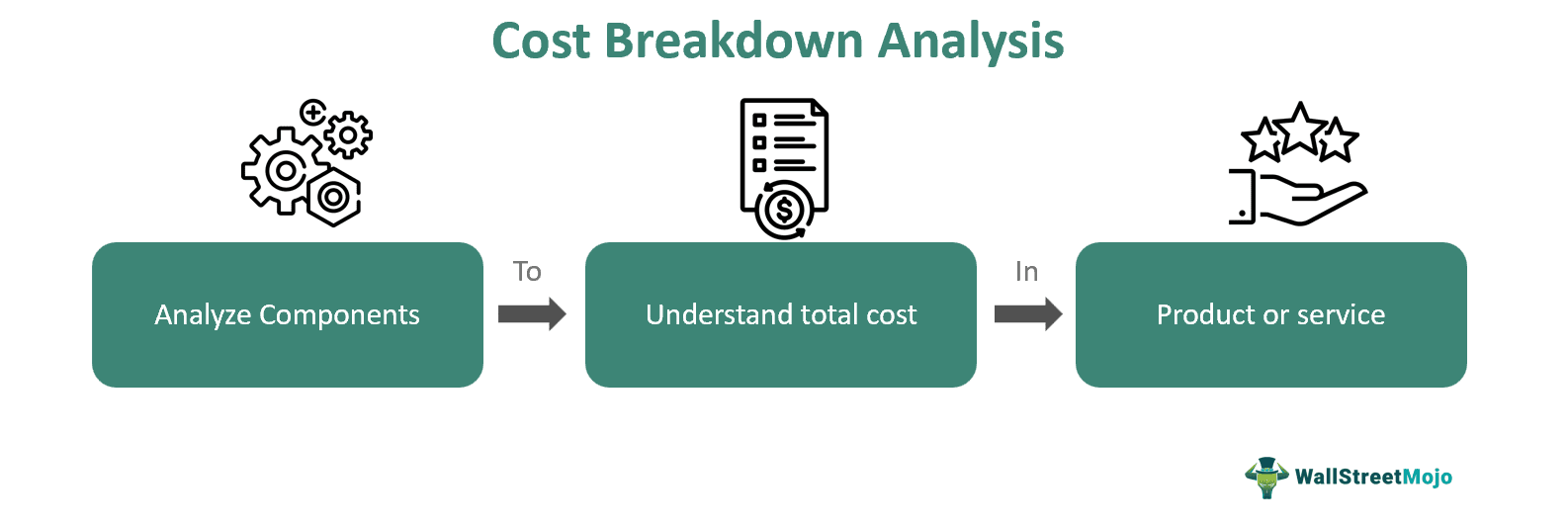Table of Contents
What Is Cost Breakdown Analysis(CBA)?
Cost breakdown analysis (CBA) refers to determining the elements that make up the full cost of a package, product, or service. It offers a comprehensive explanation of costs while helping make correct judgments about profitability, resource allocation, and pricing to reduce & save costs.

It helps to find the cost drivers of any item the vendor supplies. It allows businesses to contrast prices easily and bargain for better rates. It aids in identifying why prices of services or items fluctuate. Sellers use it to ascertain that clients get charged for everything related to their transactions.
Key Takeaways
- Cost breakdown analysis (CBA) identifies components contributing to the total cost of an item or service.
- It is vital for obtaining a detailed understanding of costs, facilitating informed profitable decisions, cost reduction, and resource allocations.
- It involves identifying a product or service, collecting data from various sources, expanding key cost elements, identifying cost drivers.
- Also involves calculating relevant costs, preparing supplier conversations, developing insights, implementing improvements, and utilizing technology.
- Its importance is – providing a framework for assessing benefits and cost, helping in informed decisions, determining project feasibility, simplifying complex decisions, quantifying metrics, and project ranking based on meri
Cost Breakdown Analysis Explained
Cost breakdown analysis is defined as a process to gain insight into all singular cost factors that determine an item's price by segregating a supplier’s overall cost into individual components. It helps the development of suppliers as it provides ample knowledge to determine the weaknesses and strengths of a supplier. It aims to gain insight into various cost drivers to influence these to contain expenses to the lowest level in the long term.
It consists of procedures namely data gathering, systematic breakdown of cost factors, determining the cost drivers, and development of insights roughly. The supplier cost breakdown analysis can also be done using a cost breakdown analysis template or cost breakdown analysis Excel, including indirect cost breakdown analysis. Moreover, major factors in direct costs entail subcontracting, raw materials, and labor. Companies can use it as a strategic tool to cut the cost of production, have straightforward business opportunities, and save substantial money.
It should be noted that the price of an item or service is the cost of manufacturing plus profit, while cost has two elements – indirect and direct costs. A business has almost no virtual influence on indirect cost, so analysis of cost breakdown focuses more on elements adding to direct cost. As a result, an organization can correctly price its items, lay a strong foundation of cost-reduction strategy, and ensure that it remains profitable and competitive. It also identifies the potential of adding a new level of transparency.
It can assist in avoiding by identifying outliers and drivers immediately. Moreover, it frees up liquidity that acts not only as a buffer but also to be reinvested in new projects. Companies utilize it in the financial aspect of a project assessment and for intricate cost controls.
Procedure (in steps)
A traditional relationship between supplier and purchaser needs proper discovery of price drivers related to the supplier's cost. In such cases, a purchaser has to follow the below main steps for CBA:
Step 1 - Identification of product, service or item for CBA
Step 2 - Data Collection
The data regarding a product or service to be analyzed under the CBA framework has to be collected from the Enterprise resource platform (ERP), Procurement systems, Supplier invoices, spend analysis summaries, and price history recorded in the supplier database.
Step 3 - Expansion of Key Cost Elements Systematically
After selecting the product or service for CBA, one has to expand the key 6 cost components – logistics, profit, overhead, materials, labor, and conversion costs (factory, & labor).
Step 4 -Identifying Cost Drivers
Utilize different sources like expert consultation, internal & external third-party databases, and open data sources as they comprise direct, indirect & fixed costs that impact overall expenses.
Step 5 - Calculating Relevant Costs
Determine the estimated higher prices per supplier's CBA to analyze new costs, like if labor cost increases by 25 %, then its impaction other heads.
Step 6 - Prepare Supplier Conversation
Identify the mismatch between supplier demand price and actual price per CBA. Then, calculate the percentage difference to discuss with the supplier for negotiation and create new avenues for price cuts.
Step 7 - Develop Insights
Try to employ CBA to assess and benchmark data to increase business value. Also, explore reverse engineering to understand product cost structure influencing decision-making and negotiations.
Step 8 - Implement Improvements
Put to use the CBA insights to negotiate for better supplier terms, enhance efficiency, and streamline the supply chains. Additionally, lean manufacturing practices and focused, high-quality production must be implemented to reduce overall manufacturing costs.
Step 9 - Utilize Technology
Finally, implement the MRP or cloud-based ERP system to handle manufacturing costs through optimized inventory, planned productions, required material, cost analysis, and integrated accounting.
Examples
Let us use a few examples to understand the topic.
Example #1
Let us assume Ramen makes a widget for a hundred dollars. The cost of its parts is 25 dollars, whereas the remaining $75 will be the labor cost. This means 75% is spent on labor and 25% on software or hardware costs. Now, if a buyer, Chromio Corp, purchases it from ramen for $150, the buyer must understand whether the transaction was loss-making.
Hence, Chromio Corp finds that ramen charges are too high for the widget after using the previous cost breakdown assessment. On the other hand, if the company pays only $80, ramen might suffer a loss.
Example #2
An article published on October 17, 2023, revealed the actual cost breakdown of making an iPhone 15 pro max. The total material bill for making the iPhone 15 pro max is $558, 12% more than the previous model. The increase in cost has been attributed to the use of highly expensive components like the A17 Pro chipset, titanium-clad frame, and the tetraprism telephoto camera. These are responsible for the increased cost by 27% and 43%.
However, Apple decided to maintain a stable price for all models except for the new current model despite suffering from higher production costs. iPhone 15 pro max starts at $1199 which is 8% higher in increase in its price. Furthermore, Apple has been observed to have a profit margin of 53 % on every unit sold. Nevertheless, despite the excessive price rise, the iPhone 15 Pro Max has become the top choice for Apple customers worldwide.
Importance
Cost breakdown analysis has a lot of importance for manufacturers as it helps in their profitability, as listed below:
- CBA provides a systematic framework to evaluate benefits and expected costs to aid in making informed choices.
- It helps in determining the financial feasibility of a project before undertaking it.
- It simplifies complex decisions, gives unbiased evaluations, and exposes hidden costs plus benefits.
- It quantifies financial and non-financial metrics supporting data-driven decision-making.
- It offers a window to know about opportunity costs, opening doors to benefits from alternative choices.
- It aids in resource optimization.
- The government can use it in feasibility studies in their projects to assess social impact and project viability.
- It also helps in the risk assessment of a project.
- Its credibility is enhanced in times of uncertainty with the use of sensitivity analysis.
- CBA helps businesses in ranking projects per their merit, nullifying bias over the profit of the business.

